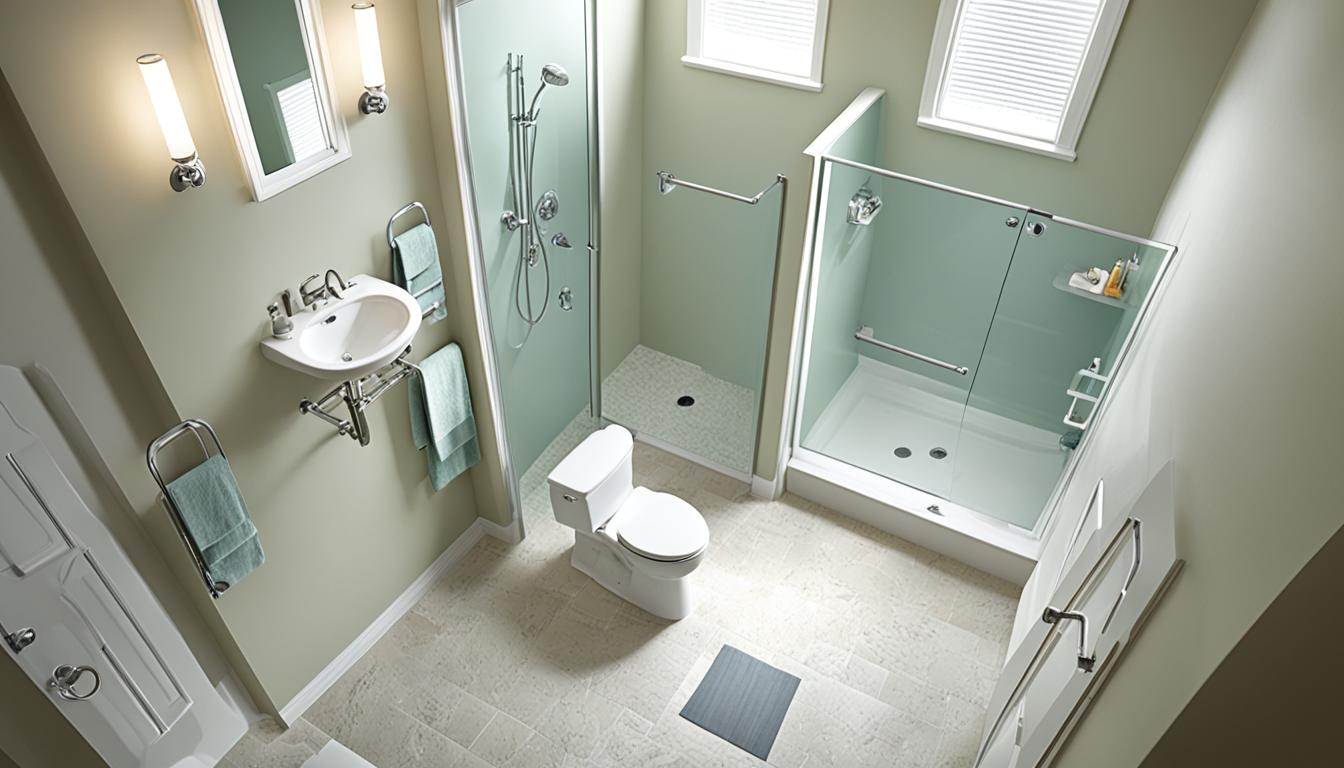Ever thought about making a bathroom that helps people with mobility issues or disabilities1? Making an accessible bathroom can make daily life easier and better1. By adding features for those with mobility challenges, you make a bathroom safe, stylish, and comfy. This guide will show you how to design an accessible bathroom that’s easy for everyone to use.
Falls in the bathroom are more likely to cause injuries than anywhere else in the house1. This is especially true for older people or those with disabilities1. With the right design, you can lower the chance of accidents and make living easier and more comfortable.
When making an accessible bathroom, follow the Americans with Disabilities Act (ADA) guidelines1. These rules help make sure public places are easy for people with disabilities to get into1. Think about adding a big shower, no curb, grab bars, and shelves that are easy to reach for an Accessible Bathroom Interior Design.
Focus on important things like enough floor space, where the toilet and sink are, and walk-in showers23. A wheelchair is 24-27″ wide, so the bathroom door should be at least 32″ wide, better if it’s 36″2. The ADA also says spaces should be 60″ in diameter and there should be at least 60″ around the toilet for easy access2.
Creating an accessible bathroom takes a lot of thought, but it’s worth it. It makes life easier, welcomes everyone, and ensures a safe and comfy place for all. So, let’s explore Accessible Bathroom Interior Design and make your bathroom better for everyone.
Importance of Accessible Bathroom Designs
Accessible bathroom designs are key for Aging-in-Place Bathroom Solutions. They help people with disabilities or mobility issues stay independent and maintain their dignity4. These bathrooms make daily tasks like bathing easier, giving users control over their lives4. They also make homes welcoming for everyone, no matter their mobility needs.
Enhancing Independence and Quality of Life
Accessible bathrooms give people the freedom to do daily tasks on their own4. With grab bars, toilets at a comfortable height, and showers without barriers, they lower the chance of falls4. This helps users feel more independent and improves their life quality.
Promoting Inclusivity for All Abilities
These designs make bathrooms welcoming for everyone, no matter their abilities5. Following ADA standards, they make sure people with disabilities can use the bathroom easily on their own5. This approach helps everyone feel included and overcomes barriers to daily activities.
| Key Accessible Bathroom Features | Benefits |
|---|---|
| Grab bars at strategic locations | Provide stability and support for safe transfers and movement4 |
| Comfort-height toilets | Reduce strain on the knees when sitting down4 |
| Barrier-free showers | Allow for easy access and maneuverability4 |
| Wider doorways | Accommodate mobility aids like wheelchairs5 |
| Lever-style faucets and hardware | Easier to operate for individuals with limited dexterity4 |
By adding Aging-in-Place Bathroom Solutions and Mobility-Enhancing Bathroom Features, homeowners can make bathrooms that help everyone. These bathrooms support independence and make life better for people with different abilities45.
Key Considerations for Accessibility
When designing an ADA-Compliant Bathroom Design, think about several key factors. These include door width, floor space, grab bar placement, toilet accessibility, sink and countertop design, and shower or bathtub features6. By focusing on these areas, you can make a Universal Design Bathroom that’s safe, useful, and welcoming for everyone.
Door width is a big deal in Barrier-Free Bathroom Layouts. The Americans with Disabilities Act (ADA) says doors must be at least 42 inches wide7. Also, doors in tight spots should swing out, and handles should be easy to use with just five pounds of force6.
- For wheelchair and walker access, a bathroom door should be at least 32 inches wide6.
- Side entry bathrooms need a door that’s at least 36 inches wide for wheelchair turning6.
Having enough clear floor space is key for accessible bathrooms. You should aim for about 60 inches in diameter for clearance7. This makes it easier for people using wheelchairs or other aids to move around8.
| Accessibility Feature | Recommended Specification |
|---|---|
| Bathroom Door Width | 32 inches minimum for straight entry, 36 inches minimum for side entry6 |
| Clear Floor Space | 60 inches in diameter7 |
| Toilet Height | 16 ½ to 18 inches high7 |
| Threshold Height | Not to exceed ½ inch7 |
Bathroom fixtures and features are also vital for accessibility. Using comfort-height toilets, 16 ½ to 18 inches high, helps people with mobility issues7. Grab bars near the toilet, shower, and bathtub add support and safety78.
By focusing on these important points, you can design a Universal Design Bathroom that’s not just useful but also supports independence and inclusivity for everyone678.
Optimal Layout for Accessibility
Creating an accessible bathroom layout is key for a comfy and useful space for people with different abilities. Important things to think about include having enough clear floor space, easy entry, and placing the toilet and sink wisely910.
Clear Floor Space and Barrier-Free Entry
For wheelchair users, the bathroom needs a clear floor space of at least 60 inches wide for easy turns9. The bathroom entrance should be flat or have a low step to avoid tripping and make getting in easy10.
Toilet Placement and Sink Accessibility
Where you put the toilet and sink matters a lot for accessibility. Using wall-mounted sinks and toilets saves space and helps wheelchair users9. Adding features like adjustable showerheads and faucets with handles makes the bathroom better for everyone9.
| Accessibility Feature | Recommendation |
|---|---|
| Minimum Door Width | 32 inches9 |
| Minimum Turning Space | 60 inches in diameter9 |
| Grab Bar Material | Stainless steel or chrome-plated brass9 |
| Shower Seat Material | Water-resistant and easy to clean (e.g., teak wood or plastic)9 |
| Toilet Height | Raised toilets for better access9 |
| Flooring | Non-slip materials (e.g., ceramic tiles or vinyl)9 |
| Faucets and Showerheads | Lever-style and adjustable-height9 |
| Accessibility Indicators | Tactile indicators for those who are visually impaired9 |
By thinking about these design elements, you can make a bathroom that’s easy to use, safe, and better for everyone91011.
Space Planning and Clearances
Creating an accessible bathroom layout means careful planning and enough space. The doorway should be at least 32 inches wide for wheelchairs and mobility aids. A 36-inch width is even better12. Inside, make sure there’s a turning radius of at least 60 inches for easy turns12.
It’s also key to have enough space around fixtures for comfort and safety. The toilet should have at least 30 inches on one side and 60 inches on the other12. For the sink, aim for a height of 29 inches and a width of 27 inches12. Bobrick’s Planning Guide for Accessible Restrooms offers helpful illustrations and details for designing accessible bathrooms13.
| Bathroom Fixture | Minimum Clearance Requirements |
|---|---|
| Water Closet (Toilet) | A – 27″, B – 31″, C – 19″, D – 21″, E – 15″ to 18″14 |
| Bidet | A – 25″, B – 27″, C – 14″, D – 14″, E – 15″ to 18″14 |
| Lavatory (Sink) | A – 16″, B – 21″, C – 18″, D – 30″, E – 2″ to 6″14 |
| Shower (Interior Dimension) | A – 30″, B – 36″, C – 2″ to 8″, D – 24″ to 34″14 |
Following these guidelines for space planning and clearances helps make a bathroom that’s easy to use for everyone. It also supports living in the same home as you age1312.
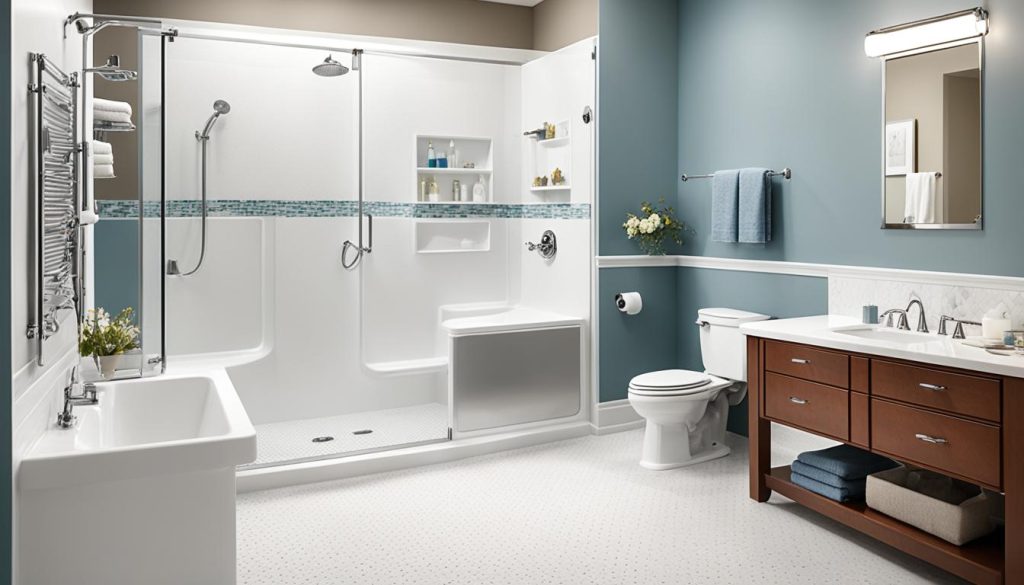
Walk-In Showers for Ease of Access
Walk-in showers are a top pick for Disability-Friendly Bathrooms because they’re easy to get into. They don’t have a high curb, making it simple for people using wheelchairs or mobility aids to get in and out. Over 25,000 customers each year choose walk-in showers15.
For a Barrier-Free Bathroom Layout, you should have at least 36 inches by 36 inches of clear floor space in the shower area16. Adding a shower seat or bench makes the space more accessible and comfy. Studies show more people want shower seats15.
Consider adding features like rainfall showerheads and matte black fixtures to your walk-in shower15. Replacing tubs with showers is quick, often done in a few days, especially if you’re using the same space15.
In small bathrooms, shower curtains are a good choice because they’re easy to clean15. Opaque or frosted glass enclosures are also popular for their style and privacy15. Floor-to-ceiling glass showers can make a room feel bigger and brighter15.
When designing the shower, place the bench near the handheld shower wand and shower niche for better access16. This way, you can make a Disability-Friendly Bathroom that looks great and works well for everyone.
Grab Bars and Handrails for Safety
Adding Aging-in-Place Bathroom Solutions and Disability-Friendly Bathrooms to your home helps everyone, no matter their abilities. Grab bars and handrails are key for safety, offering stability and support. They should be installed right and in the right. This helps with moving around and staying balanced, making life easier and more independent.
Proper Installation and Placement
Grab bars and handrails must be securely attached to walls, able to hold a lot of weight17. A basic grab bar costs about $15.70, while a fancy one with teak accent is $25.5017. It’s best to put them near the toilet, shower, and sink so they’re easy to reach and use18. A grab bar for the bathtub is super useful, and you can also use them as towel bars18.
In a Disability-Friendly Bathroom for wheelchair users, grab bars are placed where they’re most needed18. At home, grab bars are set up to help with specific challenges, like needing help or being taller18.
Adding things like a fold-down shower seat changes how grab bars should be placed for safety and easy access18. Grab bars in the right spots can stop falls, helping people stay independent. This makes Aging-in-Place Bathroom Solutions better for everyone1817.
Wheelchair Accessible Sinks and Countertops
Creating a disability-friendly bathroom means focusing on wheelchair-accessible sinks and countertops. These are key for people using mobility aids, offering both function and comfort19.
Wheelchair-accessible sinks should be between 29 and 34 inches high. This height lets users in wheelchairs easily reach the sink19. They also have enough knee space for easy positioning19. Lever-style faucets and handles make it easy to use the sink for those with less strength or dexterity19.
In a universal design bathroom, sinks and countertops are usually 32 inches high. This height suits both tall and short people20. The wide wall space, up to 12.5 feet, helps plan the vanity area. It allows for separate vanities or a single long countertop20.
| Wheelchair-Accessible Sink Features | Specifications |
|---|---|
| Sink Height | 29 to 34 inches from the floor19 |
| Sink Depth | No deeper than 6.5 inches19 |
| Faucet Operation | Operable with one hand, requiring no more than 5 pounds of pressure19 |
| Common Sink Types | Wall-mounted, height-adjustable, ADA vanity, undermount, vessel, and pedestal sinks19 |
| Sink Materials | Ceramics, porcelain, stainless steel, and marble19 |
In an accessible bathroom design, the focus is on the user’s needs, like Matt’s, who uses a wheelchair20. The design ensures easy access and functionality for him20. It’s important to balance looks with accessibility in the design20.
By focusing on wheelchair-accessible sinks and countertops, you make a disability-friendly bathroom. This approach supports independence, safety, and comfort for those with mobility issues19. It ensures your bathroom meets everyone’s needs, creating a welcoming space for all21.
Accessible Bathroom Interior Design
Creating an Disability-Friendly Bathroom is more than just adding accessible features. It’s also about making it look good. By choosing fixtures and finishes that are both useful and nice to look at, you can make a bathroom that’s both useful and beautiful. This means picking out items that meet Inclusive Bathroom Remodeling needs but also add to the room’s look and feel.
When designing an Universal Design Bathroom, finding the right balance between looks and function is key. Choose fixtures that are not only useful but also look good, like sleek grab bars that fit right in. Floating and wall-hung sinks are great for easy wheelchair access. Handheld shower heads make it easier for helpers, and walk-in showers are both useful and popular in modern bathrooms22.
Add design touches that make the bathroom feel like a spa, like hanging lights and monochrome color schemes. Space-saving built-in storage solutions and minimalistic tiles are also in style for accessible and small bathrooms22.
By mixing accessibility with good design, you can make a Disability-Friendly Bathroom that looks and works great. This way, it’s not just for everyone, but it makes the bathroom experience better for everyone232221.
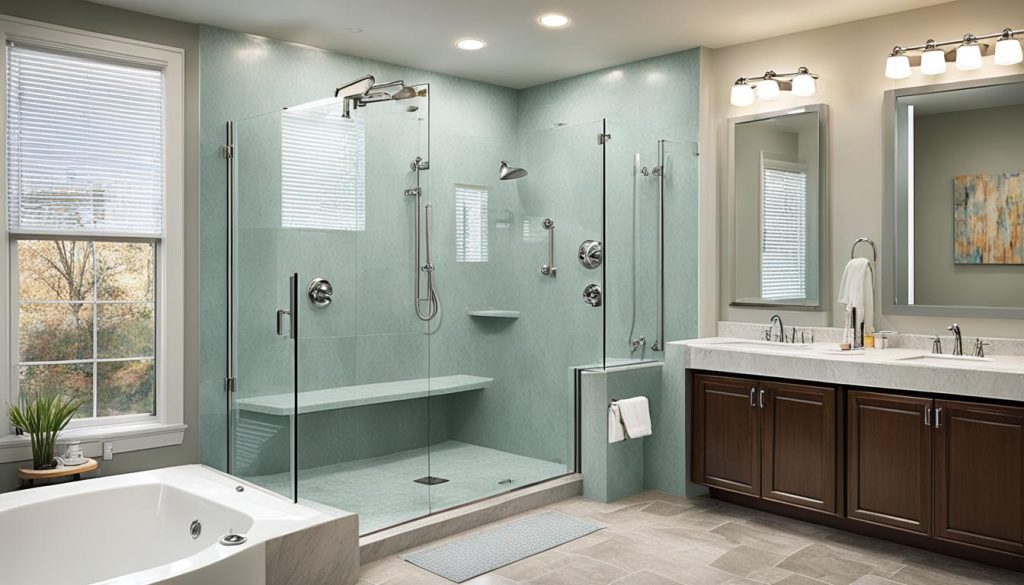
Door Width and Entryway Considerations
Creating a Disability-Friendly Bathroom means paying close attention to the entryway and door size. This ensures Wheelchair-Accessible Bathroom Amenities. Doors must be at least 36 inches wide for easy access24. Corridors with more than 10 people need to be 44 inches wide, and those with fewer people should be 36 inches wide24. This makes it easier for people using wheelchairs or mobility aids to move around.
Typically, bathroom doors are 32 inches wide, which might not fit wheelchairs25. But, you can widen doors by up to 2 inches with special hinges, making them at least 36 inches wide25. It’s also good to have a low or no threshold at the door to prevent tripping.
Accommodating Wheelchairs and Mobility Aids
It’s key to make sure the bathroom entryway and door fit wheelchairs and mobility aids24. Different views on ADA rules can cause disagreements during building projects24. By focusing on these design points, people with mobility issues can have a bathroom that’s fully accessible and comfortable.
| Design Consideration | Recommended Specification |
|---|---|
| Minimum Clear Width | 36 inches (915 mm)24 |
| Corridor/Hallway Width (Occupant Load ≥ 10) | Minimum 44 inches (1118 mm)24 |
| Corridor/Hallway Width (Occupant Load | Minimum 36 inches (914 mm)24 |
| Standard Doorway Width | 32 inches25 |
| Expandable Door Width | Up to 2 inches increase25 |
| Recommended Minimum Door Width | 36 inches25 |
Lighting for Visibility and Comfort
Creating an Inclusive Bathroom Remodeling or Universal Design Bathroom means thinking about lighting carefully. Good lighting is key for a safe, easy-to-use, and comfy bathroom for everyone, including those Aging-in-Place. With smart lighting, you can make sure the space is bright, has no dark spots, and lets users control the light, making it both nice to look at and useful.
LED lights use much less energy than old bulbs26. They turn more energy into light than heat, which means lower bills and less harm to the planet26. Plus, LEDs last a long time and use little power, making them a smart choice for the planet and your wallet26.
Adding LED vanity lights and LED lighted bathroom mirrors brings energy efficiency and long life. Low-profile LED recessed lighting fixtures give light without using much energy or making heat26. And exhaust fans with integrated LED lights are great because they remove bad smells and moisture while lighting up the space26.
Using natural light through windows or skylights makes the bathroom look better and feel welcoming27. Natural light is good for people, helping with sleep and stress27.
With adjustable lights like dimmers or motion sensors, people can set the light just right for them27. Making sure lights are easy to reach and avoiding glare is also key for an Inclusive Bathroom Remodeling or Universal Design Bathroom.
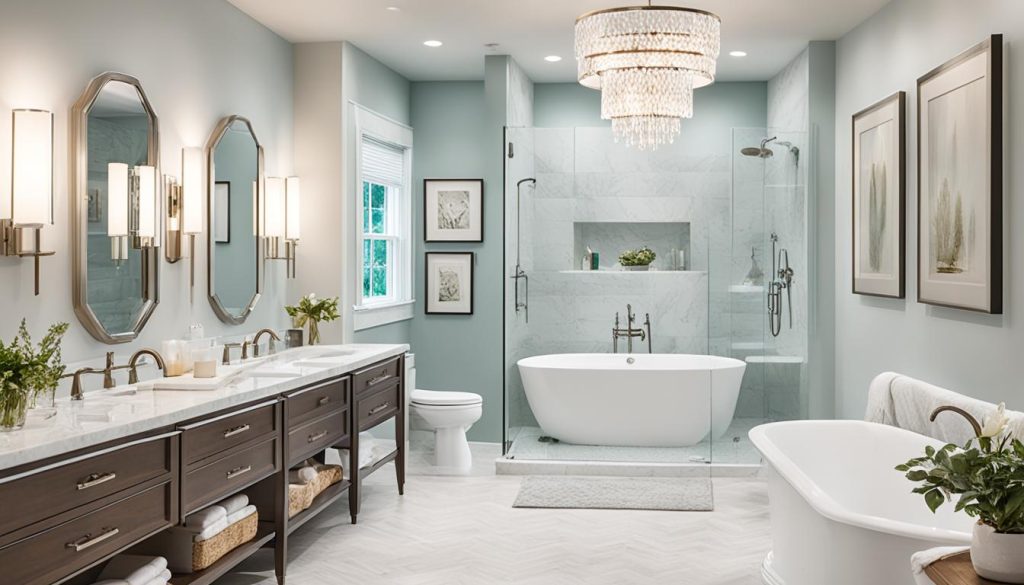
Flooring and Surface Materials
Choosing the right flooring and surfaces in an accessible bathroom is key for safety and comfort. It makes moving around easier for people with disabilities or mobility issues28. Bathrooms are a common place for falls, so the flooring is very important for safety28.
Non-Slip Surfaces and Smooth Transitions
Non-slip flooring, like textured tile or slatted wood, helps prevent slips, especially in wet areas like showers and around sinks28. Vinyl flooring is great for everyone because it’s easy to grip, keeps water out, is good for wheelchairs, and is affordable2829. Bathroom floor tiles are also a good choice because they last long, don’t slip, resist water damage, and add value28.
It’s also key to have smooth floors where different surfaces meet to help wheelchairs and other aids move easily28. Natural stone is tough and doesn’t let water in, but it might be hard for some to walk on2830. Concrete floors are strong and dry, making them easy for wheelchairs, but they can get slippery when wet28.
Using different colors for the floor and walls helps people with vision problems tell where one area ends and another begins. This makes the bathroom more accessible30.
| Flooring Material | Benefits for Accessibility |
|---|---|
| Vinyl | Excellent traction, water repellent, wheelchair friendly, affordable |
| Bathroom Tiles | Durable, non-slip surface, resistant to water damage, value-adding |
| Natural Stone | Durable, moisture-resistant, but may not be the most accessible due to texture |
| Concrete | Durable, water-resistant, smooth surface for wheelchairs, but can be slippery when wet |
By picking the right flooring and surfaces, you can make bathrooms safe, easy to use, and accessible for everyone282930.
Fixtures and Faucet Accessibility
When designing a Disability-Friendly Bathroom, picking the right fixtures and faucets is key. ADA-compliant toilets meet certain height and space standards. This makes them easy to use for people with different abilities31.
Using lever-style or touchless faucets is a good idea. They make it easy for those with less strength or dexterity to use31. Also, think about the height and where you place these items. This makes them reachable for everyone, even those in wheelchairs31.
Grab bars near toilets, tubs, and showers make bathrooms safer and easier to use31. Shower benches give a place to sit while bathing. They’re great for seniors or anyone who has trouble moving around31.
Getting expert advice is important for making sure your bathroom follows ADA rules. It’s key to know the guidelines to make a bathroom that’s easy for everyone to use31.
| Fixture | Recommendation |
|---|---|
| Toilet | Comfort-height toilets with a seat height of 17-19 inches from the floor32 |
| Vanity/Countertop | Adjustable-height countertops to accommodate users’ varying needs32 |
| Grab Bars | Install on both sides of the toilet, in the shower, and near the bathtub32 |
| Shower Controls | Position within easy reach when standing or sitting32 |
| Faucets | Lever handles, touchless technology, or single-handle operation32 |
By adding these Universal Design Bathroom features, you can make a Disability-Friendly Bathroom that looks good and works well. It meets the needs of everyone who uses it31.
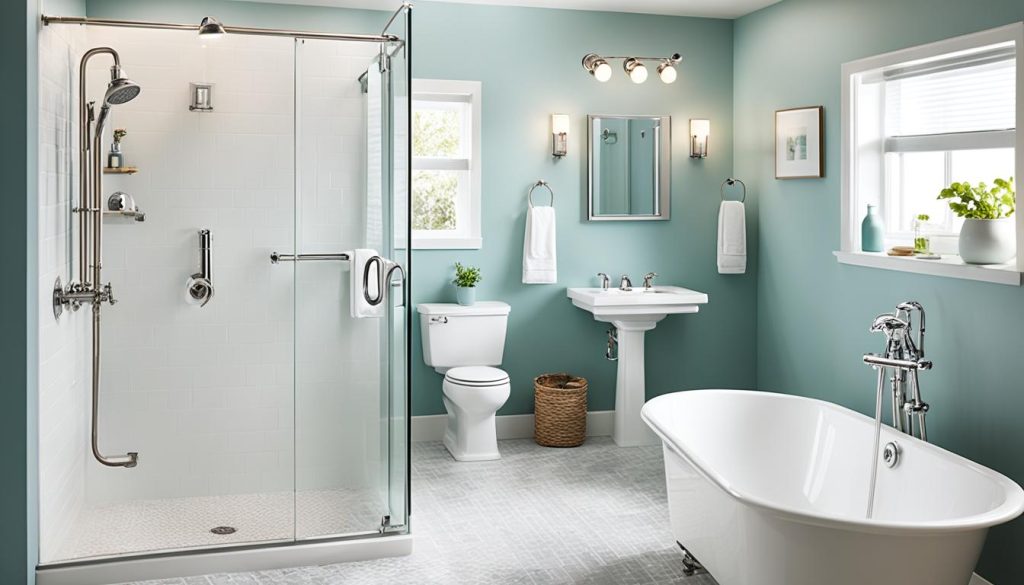
Safety and Accessibility Features
Creating a disability-friendly bathroom is more than just making it open and easy to get around. It’s about adding features that help users stay independent and improve their lives. Things like emergency call systems and adjustable showerheads can really change the game for an33 inclusive bathroom.
Re-Bath is a top choice for making bathrooms accessible. They offer many features for safety and ease of use. Their slip-resistant shower bases and grab bars help prevent falls33. Plus, their walk-in bathtubs have wide doors that make getting in and out easier33 for people with mobility issues.
It’s not just about the physical stuff. Adding smart storage and emergency call systems makes bathrooms more accessible and easier to use33. With these features, you can make a bathroom that suits everyone’s needs. It’s all about giving people independence, comfort, and peace of mind.
Source Links
- https://www.mrhandyman.com/blog/accessible-bathroom/
- https://www.roomsketcher.com/blog/accessible-bathroom-design/
- https://www.springhills.com/resources/accessible-bathroom-designs
- https://www.angi.com/articles/universal-design-boosts-bathroom-accessibility.htm
- https://allorausa.com/blogs/news/the-ultimate-guide-to-designing-an-ada-compliant-bathroom
- https://udservices.org/accessible-bathroom-remodels/
- https://kitchensbyeileen.com/2023/04/05/accessible-bathroom-design/
- https://www.linkedin.com/pulse/design-considerations-accessible-aging-in-place-2vcbe?trk=article-ssr-frontend-pulse_more-articles_related-content-card
- https://liveinplacedesigns.com/handicap-bathroom-layout-tips/
- https://www.deslaurier.com/en-us/learning-centre/creating-an-accessible-bathroom-design
- https://baystateremodeling.com/blog/ultimate-guide-accessible-bathroom-remodeling-for-handicap-accessibility/
- https://bestbath.com/wp-content/uploads/2017/10/Bestbath-Universal-Design-Top-10.pdf
- https://www.bobrick.com/pgar/
- https://www.graphicstandards.com/2019/02/05/bathrooms-and-layouts-residential-bathroom-design/
- https://www.affordablewalkinshower.com/
- https://dickeys-inc.com/walk-in-showers-for-accessible-bathrooms-enhancing-safety-and-convenience/
- https://www.grabbarspecialists.com/
- https://carlaaston.com/designed/can-bathroom-with-grab-bars-look-beautiful
- https://www.patientsafetyusa.com/blog/choosing-a-wheelchair-accessible-bathroom-sink-ada-requirements/
- https://www.addicted2decorating.com/master-bathroom-vanity-considerations-with-accessibility-in-mind.html
- https://www.toulmincabinetry.com/blog/how-to-design-an-accessible-kitchen-and-bathroom
- https://www.mobility-plus.co.uk/blog/inspiration/top-accessible-bathroom-design-ideas/
- https://www.archdaily.com/897689/plan-and-design-accessible-bathrooms-for-all-with-this-ada-design-guide-for-washrooms
- https://www.contractortalk.com/threads/ada-requirement-for-hallway-leading-to-bathrooms.104450/
- https://udservices.org/making-your-entryway-safer/
- https://www.modobath.com/inspiration/the-art-and-science-of-bathroom-lighting-design/
- https://www.modobath.com/inspiration/unique-lighting-methods-for-a-modern-bathroom/
- https://accessablehomes.com.au/types-of-flooring-for-accessible-bathrooms/
- https://www.sunwooddevelopment.com/building-blog-ct/how-to-choose-low-maintenance-bathroom-remodeling-materials
- https://www.linkedin.com/pulse/flooring-bathrooms-how-ensure-clean-dry-pleasing-paven-raj-pmp
- https://getcoloradoliving.com/blog/choosing-the-right-fixtures-and-accessories-for-an-accessible-bathroom/
- https://www.bathroomremodelingmd.com/accessible-bathroom-design-guide
- https://www.rebath.com/blog/accessible-bathroom-remodel-how-to-make-your-bathroom-wheelchair-safe/

